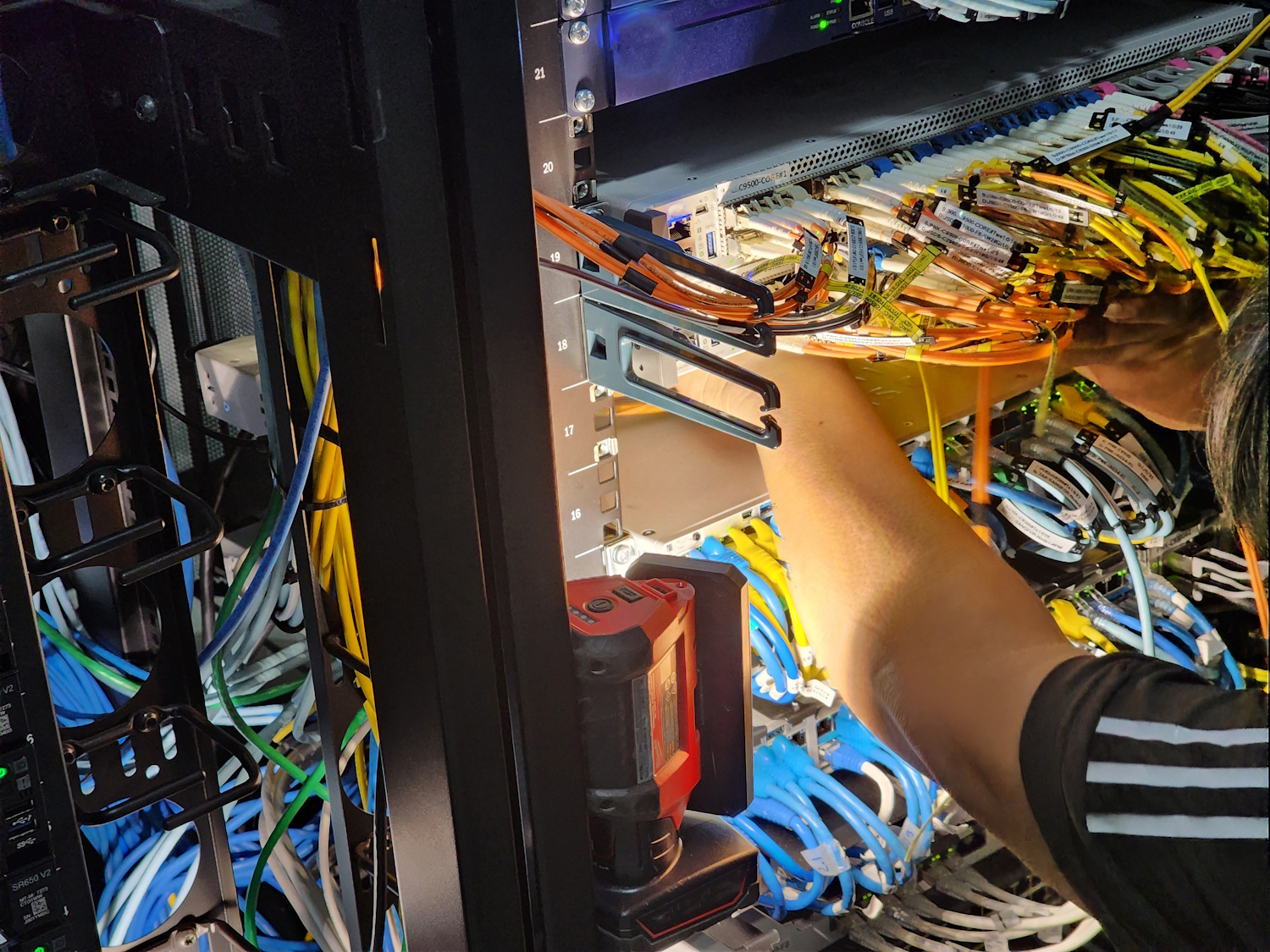In today’s connected world, every organisation – from government offices and schools to hospitals, factories, and corporate businesses relies on networking to operate effectively. A key IT infrastructure decision is choosing between wired vs wireless networks (or a mix of both) to support your operations. Both wired and wireless solutions have unique benefits and drawbacks.
This article explores the advantages of wired networks and the drawbacks of wireless networks, and vice versa, to help you determine the best fit for your business IT environment.
What are wired Networks?
A wired network uses physical cabling (such as Ethernet cables or fibre optics) to connect computers, servers, printers, and other devices. These cables plug into network switches or routers, forming a reliable, high speed communications backbone.
Wired networks often require careful planning and network installation by professionals – usually involving structured cabling runs, patch panels, and networking hardware. Many organisations work with an experienced Data Cabling Company to design and deploy their wired infrastructure correctly from the start.
Advantages of Wired Networks
Wired networks have long been the standard in enterprise and industrial settings because of several key advantages. Here are some of the benefits of wired connections:
Speed and Performance: Wired connections generally offer faster data transfer speeds and lower latency than wireless. With modern Gigabit Ethernet (1 Gbps) and even 10 Gbps cabling, a wired LAN can handle large file transfers, video conferencing, and cloud applications with ease and minimal delay. Unlike Wi-Fi, wired throughput doesn’t degrade with distance or interference – there’s no signal drop-off based on proximity to a router.
Reliability and Stability: A wired network connection is highly stable. It isn’t susceptible to radio interference, signal fading, or bandwidth contention in the way wireless is. Once cables and switches are properly installed, you have a solid, always-on connection. There are no wireless “dead zones” with Ethernet – as long as a device is plugged in, it’s online without the variability that Wi-Fi can experience.
Security and Control: Wired networks offer a level of inherent security since data travels inside cables rather than through the air. It’s nearly impossible for an outside party to eavesdrop on a wired connection without physical access to the cable or network hardware. By contrast, Wi-Fi signals can potentially be intercepted from outside the building if not well secured. With the proper firewall and network access controls in place, a wired network is a closed system for your authorised users
Low Latency: For applications that require real-time responsiveness (such as VOIP calls, online training simulations, or remote machine control in industrial settings), wired connections tend to have lower latency (delay) and jitter.
When things work as they should, you barely notice. But when something goes wrong, it quickly becomes everyone’s problem. A well-built infrastructure keeps your business running behind the scenes. If you’re unsure where to start, speaking to a provider like Nortech can help you figure out what’s working and what isn’t.
Disadvantages of Wired Networks
Despite their strengths, wired networks come with some drawbacks that organisations must consider:
Lack of Mobility and Flexibility: Perhaps the biggest disadvantage of a wired network is that devices are tethered to cables. Users cannot easily roam around with a desktop PC or any device that must stay plugged into an Ethernet port. If you need to relocate a computer or add a new workstation in a different area, you’ll have to run new cabling to that spot.
Installation Time and Cost: Setting up a comprehensive wired network often requires upfront effort. Cabling an entire office building or campus involves routing cables through walls, ceilings, or conduits, which can be labour intensive and may require data cabling specialists.
Port Limitations: Each wired device needs an available port on a switch or router. If you suddenly have more devices than ports, you must install additional hardware.
Cable Clutter and Aesthetics: Running many cables can lead to clutter if not well managed. An office with cables sprawled across floors or walls not only looks disorganised but can also pose tripping hazards or get accidentally unplugged by staff or cleaners. Properly concealing and labelling cables (often by using trunking, cable trays, or underfloor cabling systems) is necessary and requires planning.
Despite these disadvantages, many of these issues can be mitigated with good planning and professional installation. Working with the right partners for network installation (e.g., structured cabling experts and IT infrastructure services providers) can minimise installation hurdles.
What are Wireless Networks?
A wireless network, typically Wi-Fi for business use, connects devices using radio waves instead of cables. Access points or wireless routers broadcast a Wi-Fi signal that laptops, tablets, smartphones, and other Wi-Fi enabled devices use to communicate with the network. Wireless networking has become extremely popular due to the rise of mobile computing and BYOD (bring your own device) practices.
From open plan offices to schools and hospitals, Wi-Fi allows staff and guests to connect without plugging in. Business WiFi and WiFi Installation solutions focus on placing adequate wireless access points, controllers, and antennas to provide coverage and capacity where needed. Compared to wired setups, wireless networks are quicker to deploy in many cases.
Advantages of Wireless Networks
The advantages of wireless networks largely centre around freedom and flexibility. Key benefits include:
High Mobility and Flexibility: Wireless networking enables employees and users to move freely throughout a building or campus while staying connected. There’s no need to be at a specific desk or tethered by a cable. For example, in an educational setting, students with laptops or tablets can collaborate in different areas of a classroom or library without losing network access. In a business, staff can bring a laptop into a meeting room and still pull up files or cloud apps during the discussion.
Ease of Installation and Expansion: Setting up a wireless network can be faster and less labor-intensive than wiring an entire facility. Fewer physical components are needed. For small offices, a single wireless router might cover the space with minimal setup. Even for larger premises, installing a dozen Wi-Fi access points is usually quicker than pulling hundreds of cables to desks.
Clean Aesthetics and Less Clutter: Because there are no wires running to user devices, wireless networks keep office spaces neater. This is more of a cosmetic or practical benefit than a technical one, but it can be important for maintaining a safe and organised environment.
Support for Many Device Types: Wi-Fi can connect a wide array of devices beyond the typical desktop PC. Smartphones, tablets, IoT devices, smart boards, and more can all share the same wireless network. This is especially useful in smart building scenarios or contemporary classrooms where various gadgets need network access.
Disadvantages of Wireless Networks
Potential Connectivity Issues (Interference & Range): Wireless networks are vulnerable to interference and environmental factors. Radio signals can be weakened or disrupted by obstacles like thick walls, metal shelving, machinery, or even other electronic devices emitting signals. This can result in Wi-Fi “dead spots” or areas of weak signal where connection quality suffers
Security Concerns: By its nature, a wireless network’s signals extend beyond the confines of your building (even if just slightly). This means that without proper security, unauthorised individuals could attempt to connect or eavesdrop from outside. Wireless security has improved greatly (with strong encryption standards like WPA2/WPA3), but a poorly secured Wi-Fi is an easy target for hackers
Speed and Bandwidth Limitations: Although Wi-Fi technology has advanced (with Wi-Fi 6 and upcoming Wi-Fi 6E/7 offering higher speeds), wireless data rates and consistency still usually lag behind wired connections. A wired Gigabit Ethernet link offers up to 1000 Mbps full-duplex reliably to one device. In contrast, a wireless access point might advertise 1200 Mbps (on Wi-Fi 6), but that is shared among all devices and is highly contingent on signal quality and interference. Real-world wireless speeds per device are often much lower than the theoretical max.
Reliability and Uptime: Because wireless relies on radio signals, it introduces additional points of potential failure that are outside of IT control. For instance, a sudden source of interference could knock out the Wi-Fi in part of your building (say, a neighbour installing a powerful wireless device or an unusual radio emission). Dense concentrations of users (such as a full conference room) can overwhelm a single access point’s capacity, causing slower speeds or drops.
Despite these disadvantages, wireless networks can be designed to be robust and secure. It often starts with proper planning: performing a professional Wi-Fi site survey to map signal coverage and identify interference sources, then deploying sufficient access points with the right configuration.
Wired vs Wireless Network: Which is Best for Your Business?
When it comes to wired vs wireless for your organisation, the best choice truly depends on your specific needs, environment, and usage requirements. In many cases, a hybrid network that uses both wired and wireless elements will offer the most flexibility and performance.
Here are some factors and recommendations to consider when deciding on your network infrastructure:
- Nature of Your Operations: Evaluate how your employees or systems use the network. Do you have many mobile users with laptops or tablets who need freedom to move (pointing toward wireless)? Or do you primarily have fixed workstations, servers, or high-bandwidth devices that need steady connections (favouring wired)?
- Security and Compliance Requirements: If your business handles highly sensitive data (financial records, personal health information, government classified materials, etc.), you may have strict security policies that favour wired networks or very tightly controlled wireless. Government and healthcare sectors, for instance, often enforce strong encryption and may prefer wired for certain segments of the network.
- Scale and Growth Plans: Think about the number of devices you need to connect now and in the future. Wireless can be scaled up quickly by adding more access points, but at a certain point the airwaves can get crowded if hundreds of devices are online in proximity. Wired networks require planning for sufficient switch ports and cabling to future desks or equipment.
FAQs
Yes. A hybrid approach is considered best. Using wired connections for stationary devices (like desktops or printers) and wireless for mobile users.
Wired networks are generally considered more secure because they require physical access to connect. Wireless networks can be secured with encryption (like WPA3) and strong access controls, but they are more vulnerable to interception if not properly configured.
It depends on your environment. Small offices may benefit from wireless for ease and flexibility, while businesses with high performance or security needs might choose wired or a combination of both for scalability and reliability.
Wireless signals can be disrupted by walls, metal, other wireless devices, and even microwaves. Proper network design, access point placement, and channel management help reduce interference.
About Nortech Network Services
At Nortech, we are an independent IT infrastructure company with offices in Northampton and Milton Keynes. Since 2000, we’ve helped businesses across the UK get connected, stay secure, and work smarter.
From cabling and wireless to AV, security, and IT support, we handle the lot. Our engineers know their stuff, and because we’re vendor-neutral, you get advice that’s honest and cost-effective.
If your systems are slow, outdated or holding your business back, give us a call. We’ll help you sort it out without the jargon or drama.



